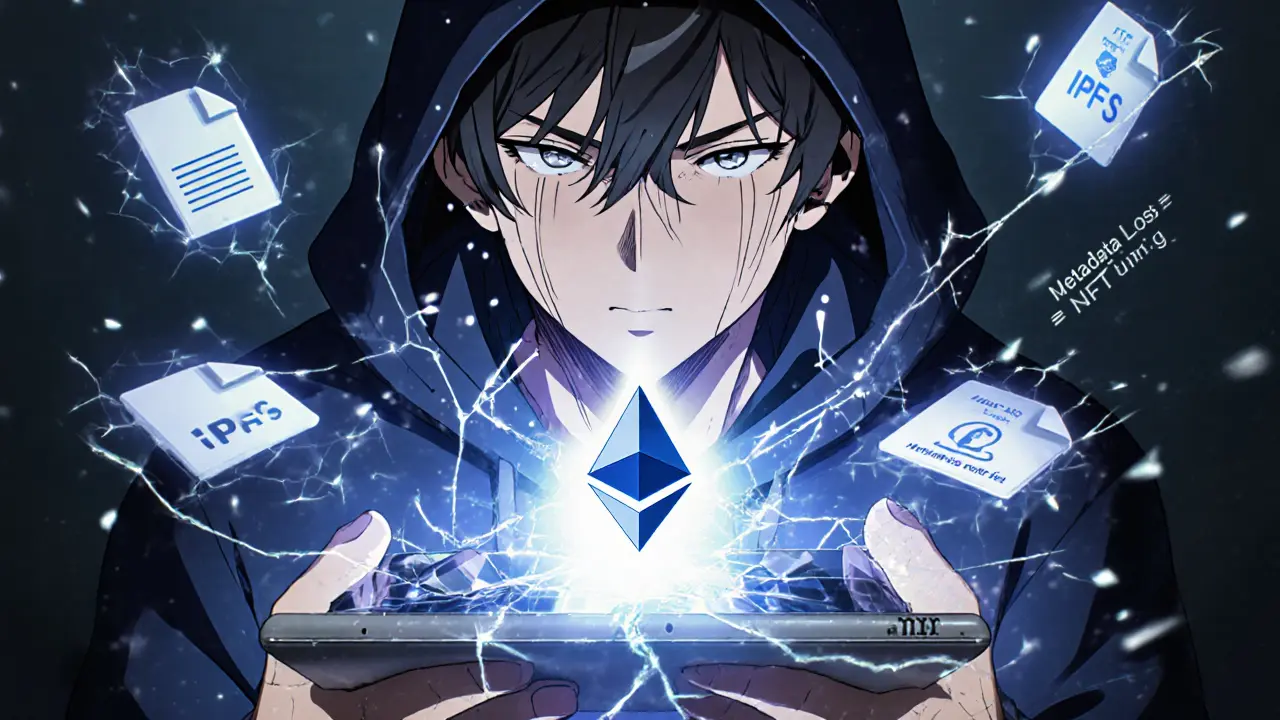ERC-721 Gas Cost Calculator
Estimate Your NFT Minting Costs
Based on current Ethereum network conditions
Per Token: 0.00 ETH
The ERC-721 NFT standard is what makes digital collectibles, art, and game items truly ownable. Unlike cryptocurrencies like Ethereum or Bitcoin, where every unit is identical and interchangeable, ERC-721 creates digital assets that are one-of-a-kind. Think of it like owning the original Mona Lisa versus a printed poster - both are images, but only one has verifiable uniqueness and provenance. This standard, introduced in early 2018, turned the blockchain from a ledger for money into a registry for digital ownership.
What Makes ERC-721 Different from Other Tokens
Before ERC-721, most tokens on Ethereum followed the ERC-20 standard. Those tokens are like cash: one ETH is always equal to another ETH. You can swap them freely, split them, or add them up. ERC-721 flips that entirely. Each token has a unique ID - a number no other token shares - and that ID is tied to specific data about the asset. That could be a pixel art avatar, a virtual land parcel, or a digital trading card. The token itself doesn’t store the image or file. Instead, it holds a pointer - usually a link to a JSON file on IPFS - that describes the asset’s name, description, image, and attributes.
This distinction matters because it allows for scarcity. If you own ERC-721 token #4206, no one else can claim that exact token. Even if someone copies the image, they can’t replicate the ownership record on the blockchain. That’s why a Bored Ape NFT can sell for hundreds of thousands of dollars - it’s not the JPEG, it’s the verifiable proof of ownership tied to a unique identifier.
Core Functions of an ERC-721 Contract
Every ERC-721 smart contract must include nine mandatory functions and respond to three key events. These aren’t optional extras - they’re the building blocks that make NFTs work across wallets, marketplaces, and games.
- balanceOf(address owner) - Tells you how many NFTs a wallet holds.
- ownerOf(uint256 tokenId) - Returns the address that owns a specific token ID.
- transferFrom(address from, address to, uint256 tokenId) - Moves a token directly from one owner to another.
- safeTransferFrom - A safer version that checks if the receiver can handle NFTs (prevents accidental loss).
- approve(address to, uint256 tokenId) - Lets one user temporarily allow another to transfer their NFT.
- setApprovalForAll(address operator, bool approved) - Grants permission to a single address to manage all your NFTs at once.
- getApproved(uint256 tokenId) - Shows who’s been approved to transfer a specific token.
- isApprovedForAll(address owner, address operator) - Checks if an operator has blanket permission over an owner’s entire collection.
- tokenURI(uint256 tokenId) - Returns the link to the metadata file (like IPFS hash or HTTP URL).
Each time one of these functions is called, the contract emits an event: Transfer (when ownership changes), Approval (when someone is granted transfer rights), or ApprovalForAll (when bulk permissions are set). These events are what allow wallets and marketplaces to track your NFTs automatically.
How Metadata Works - And Why It Matters
ERC-721 doesn’t store the actual image or audio file. Instead, it points to a metadata file - typically a JSON document hosted on decentralized storage like IPFS. This file contains the name, description, image URL, and custom traits (like background color, hat type, or rarity score). For example, a CryptoPunk might have metadata showing: "name": "CryptoPunk #7804", "image": "ipfs://QmXy...", "attributes": [{"trait_type": "Eyepatch", "value": "Yes"}].
This design keeps the blockchain lean. Storing large files on-chain would cost millions in gas. But it also creates a risk: if the image link breaks, your NFT becomes a blank card. That’s why 78% of serious projects use IPFS or Arweave - systems designed to never lose data. Projects that rely on regular HTTP links (like a server in a company’s data center) risk losing their NFTs if the server goes down. In 2023, metadata loss was the top security issue in NFTs, accounting for 37% of incidents, according to NIST’s official report.

Gas Costs and Performance
Deploying an ERC-721 contract costs around 1.2 million gas on Ethereum. Each time you mint or transfer a token, it costs between 45,000 and 65,000 gas. That’s expensive compared to other blockchains. For someone minting 10 NFTs at once, that’s over $100 in fees during peak times.
That’s why developers created ERC-721A. Released in 2021, this optimized version batches multiple mints into a single transaction, cutting gas costs by 30-50%. Art Blocks, the NFT art platform, used ERC-721A to mint 10,000 pieces for under $500,000 in total gas - a fraction of what it would’ve cost using the original standard. Today, over 40% of new NFT projects choose ERC-721A over the base version for this reason.
How ERC-721 Compares to Other Standards
While ERC-721 dominates Ethereum, other blockchains have their own NFT standards:
| Standard | Blockchain | Market Share (2023) | Gas Cost | Key Advantage |
|---|---|---|---|---|
| ERC-721 | Ethereum | 68% | High | Strongest ecosystem, highest security |
| ERC-721A | Ethereum | 18% | Low (batched) | Cost-efficient minting |
| SPL Token | Solana | 19% | Very low | Fast, cheap transactions |
| ERC-6551 | Ethereum | Rising | Medium | NFTs as smart wallets |
ERC-721 still leads because of network effects. Nearly every major NFT marketplace - OpenSea, Blur, Rarible - is built around it. Over 92% of NFT marketplaces only support ERC-721. Even if you’re on Solana, you’re likely interacting with an ERC-721 NFT through a bridge. And for high-value NFTs - those worth over $10,000 - 92% still live on Ethereum, according to NonFungible.com.
Common Developer Mistakes
Even experienced Solidity developers mess up ERC-721 implementations. The most frequent errors:
- Forgetting to implement tokenURI() - causes NFTs to show up as blank on OpenSea.
- Using transferFrom instead of safeTransferFrom - leads to tokens being sent to contracts that can’t receive them, permanently locking them.
- Not validating recipient addresses - someone could send your NFT to a dead wallet or a scam contract.
- Hardcoding metadata URLs - if the server goes down, the NFT breaks.
- Missing approval checks - allows unauthorized transfers if the contract doesn’t verify the caller has permission.
A 2023 Chainstack survey found that 18% of integration failures were due to incorrect use of safeTransferFrom. One developer lost $12,000 in NFTs because their marketplace didn’t check if the receiver could accept tokens. OpenZeppelin’s pre-audited ERC721 library (version 4.9.3) is used by 63% of developers because it handles these pitfalls automatically.

Real-World Use Cases
ERC-721 isn’t just for JPEGs. It’s being used in serious applications:
- Digital Art - Platforms like SuperRare and Foundation sell original artworks as NFTs, with provenance tracked forever.
- Gaming - Games like Axie Infinity and The Sandbox let players own in-game items as NFTs, which they can sell or trade outside the game.
- Collectibles - NBA Top Shot sells video highlights as NFTs, with over $1 billion in sales.
- Real-World Assets - Companies like RealT tokenize fractional ownership of rental properties using ERC-721 variants.
- Enterprise - Nike’s .Swoosh platform processed 1.2 million ERC-721 transactions in Q3 2023 without a single failure. 73 Fortune 500 companies are now testing NFTs for loyalty programs, tickets, and digital IDs.
What’s Next for ERC-721
ERC-721 isn’t static. The biggest update since its launch is ERC-6551, released in mid-2023. This standard lets each NFT act as its own smart wallet. Imagine owning a virtual land NFT that can hold other NFTs, crypto, or even run automated tasks - like paying rent in ETH when a tenant claims it. By December 2023, over 12,000 token-bound accounts were already active.
Upcoming upgrades to Ethereum itself will help too. The Dencun upgrade (expected in early 2024) will reduce gas costs for NFT transactions by 10-15% through proto-danksharding. This makes minting and trading cheaper without changing the standard.
Experts predict ERC-721 will remain the dominant NFT standard through 2030. But it won’t stay the same. New versions will absorb features from ERC-721A, ERC-6551, and others. The core idea - unique, verifiable digital ownership - is here to stay.
Why This Matters to You
If you’re buying, selling, or creating NFTs, understanding ERC-721 is non-negotiable. It’s the foundation. Without it, you can’t verify if an NFT is real. You can’t trust marketplaces. You can’t trust that your asset is really yours.
Whether you’re buying a digital collectible, building a game, or just curious about blockchain, understanding ERC-721 is like understanding HTTP for the web. It’s the invisible layer that makes everything work. You don’t need to code it - but you do need to know how it protects your ownership.
The future isn’t about replacing ERC-721. It’s about building on top of it - with better gas efficiency, smarter metadata, and tighter security. As Vitalik Buterin said in 2022, it unlocked digital ownership paradigms we never imagined. And we’re still only scratching the surface.
What is the difference between ERC-721 and ERC-20?
ERC-20 tokens are fungible - each one is identical and interchangeable, like dollars or ETH. ERC-721 tokens are non-fungible - each has a unique ID and represents something distinct, like a piece of art or a game item. You can’t swap one ERC-721 token for another and expect the same value.
Can ERC-721 tokens be copied or duplicated?
You can copy the image or file linked to an NFT, but you can’t copy the ownership record. The blockchain keeps a permanent, tamper-proof log of who owns which token ID. Even if you screenshot a Bored Ape, you don’t own the token that proves you’re the official holder.
Why do some NFTs lose their images?
If the metadata link points to a centralized server (like a company’s website) and that server shuts down, the image disappears. That’s why serious NFT projects use decentralized storage like IPFS or Arweave - these systems keep files alive forever, even if the original creator disappears.
Is ERC-721 the only NFT standard?
No. Solana uses SPL, and Ethereum has improved versions like ERC-721A and ERC-6551. But ERC-721 is still the most widely supported. Over 92% of NFT marketplaces and wallets are built for it, making it the de facto standard.
How much does it cost to create an ERC-721 NFT?
Deploying the contract costs around 1.2 million gas. Minting one NFT costs 45,000-65,000 gas. That’s roughly $10-$30 per NFT during normal network conditions. Using ERC-721A can cut that cost by half when minting multiple tokens at once.
Are ERC-721 NFTs secure?
The standard itself is secure, but poorly coded contracts can be hacked. Common flaws include reentrancy attacks and missing input checks. Over 23% of audited ERC-721 contracts in 2022 had critical vulnerabilities. Always use well-audited libraries like OpenZeppelin’s, and never deploy code without testing.
Can I use ERC-721 on blockchains other than Ethereum?
Yes. Many blockchains - like Polygon, BNB Chain, and Arbitrum - are Ethereum-compatible and support ERC-721. They use the same standard but have lower fees. However, the original ERC-721 was designed for Ethereum, and it remains the most trusted version for high-value assets.

